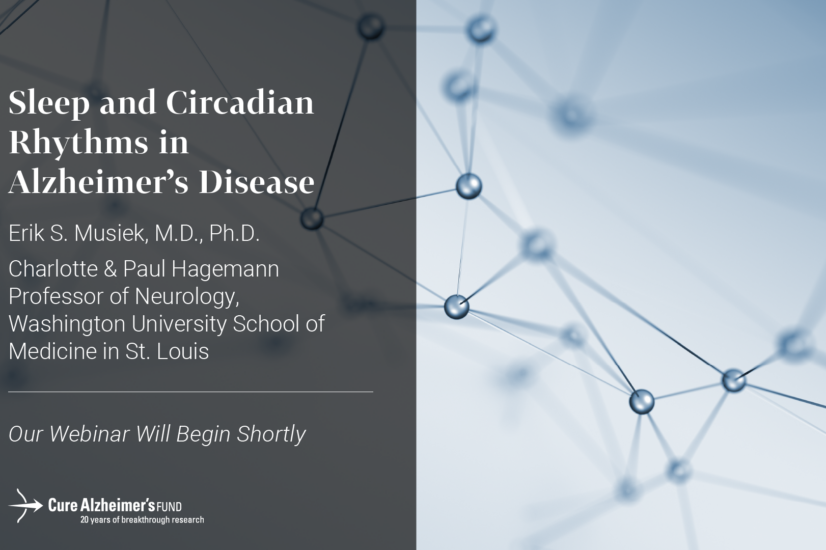
Posted August 20, 2009
Part I. Disease-Modifying Drugs Targeting A-beta
By Dr. Rudolph Tanzi, Massachusetts General Hospital
Recent developments regarding drugs aimed at treating and preventing Alzheimer’s disease (AD) by targeting the neurotoxic peptide Abeta.
This article, the first in a series of pieces reviewing promising new AD drugs in development, focuses on novel therapies based on the “A-beta Hypothesis of AD”. These drugs are aimed at retarding disease progression by curbing the accumulation of A-beta, and particularly, A-beta42, in the brain.
The four established AD genes (APP, presenilins 1 and 2, and APOE) have taught us that the common pathological feature in the AD brains of patients carrying defects in any of these four genes is the excessive of accumulation of neurotoxic A-beta. There are two basic ways to achieve this: either promote the clearance of A-beta42 from the brain, or turn down production of A-beta42 in the brain. Below, we review some of the more promising therapeutic candidates currently in clinical trials for treating AD.
Promoting A-beta42 Clearance
These drugs are aimed at blocking excessive aggregation of A-beta into toxic forms and clearing A-beta out of the brain.
There are five major trials in this category:
1. The Amyloid Vaccine (Wyeth/Elan and 15 others)
In the vaccine approach, there are two basic strategies: active vaccination and passive immunization. Active vaccination involves immunizing a patient with aggregated A-beta. This stimulates the patient to make antibodies to A-beta. The first clinical trial (Wyeth/Elan) using this approach was terminated because several of those treated developed encephalitic. In the passive immunization approach, antibodies targeted against A-beta are injected intravenously into the bloodstream. The antibodies then bind to A-beta peptides that have been exported from the brain and do not let them re-enter the brain. In this manner, A-beta levels in the brain are progressively reduced. This is a promising strategy, which is being pursued by at least 15 different companies and is currently in large phase III trials at Wyeth/Elan (Bapineuzumab). While promising, this therapy can be relatively expensive. When one considers the demographics of AD, it’s not clear whether the healthcare system will be able to support passive immunization as a long-term solution for the greater population given its cost.
Outlook: Excellent, but with a small caveat for safety issues based on some reports that accumulation of A-beta-antibody complex on blood vessels can cause micro-hemorrhages. That said, so far, this does not seem to be a significant enough event to curtail the trials, and patients are closely monitored for such events by brain imaging.
2. IVIg (Gammagard, Baxter International)
The alternative to the amyloid vaccine approach is the intravenous “IV-Ig” approach, which attempts to achieve the same goal as the vaccine. In this case, instead of injecting purified antibodies to A-beta that have been carefully prepared and purified in the lab, they inject the whole set of antibodies from donors’ plasma. The expectation is that some of the antibodies will be naturally targeted to A-beta. Clinical studies are in the very early stages. A 24-patient study unveiled last summer by Baxter showed 16 patients on Gammagard had a better cognitive response than eight patients on a placebo.
Outlook: Questionable. This approach is based on the speculation that there will be sufficient levels of natural antibodies to A-beta to mimic the effect of a targeted passive immunization strategy.
3. Alzhemed (Neurochem)
Alzhemed (Neurochem) is an orally available drug known as a GAG-mimetic, which is designed to bind to A-beta peptides and prevent them from aggregating. In this way, the drug is intended to block A-beta from aggregating into senile plaques. Phase II and III trials of this drug have failed, however, Neurochem may attempt a revised Phase III trial in the future.
Outlook: Poor. It is highly unlikely that this drug can be rescued.
4. PBT2 (Prana Biotechnology)
PBT2 (Prana) is a “metal protein attenuation compound” (MPAC) that strips zinc and copper from A-beta and thereby prevents A-beta from aggregating and from forming neurotoxic A-beta oligomers, which can impair cognition. PBT2 has been shown to dramatically reduce A-beta aggregation and accumulation in transgenic AD mouse models. It is also able to block the detrimental effects of A-beta on neuronal synapses, neurotransmission, and cognition. Phase IIa clinical trial results, which were announced in March (2008), were highly encouraging. After 12 weeks of oral administration in 78 mild-moderate AD patients, PBT2 significantly lowered A-beta42 levels in the cerebrospinal fluid, which is representative of brain A-beta42 levels in mild to moderate patients. Moreover, the drug significantly improved cognition in the treated AD patients (versus placebo treated) based on their performance on two neuropsychiatric tests for “executive memory”. Importantly, the drug had no side effects or adverse events and was well-tolerated. Prana, co-founded by RC chairperson, Dr. Rudy Tanzi is now seeking a big pharma partner to proceed to a larger phase IIb (or phase III depending on the partner) clinical trial of PBT2.
Outlook: Excellent. PBT2 has the added benefit that it can be taken orally.
5. AZD-103 (Transition Therapeutics)
AZD-103 (Transition) is a sugar-like compound known as an “inositol” that is aimed at breaking down A-beta aggregates. In a phase I clinical study, AZD-103 was well tolerated. Transition as now partnered with Elan to carry out a phase II clinical trial.
Outlook: Fair. The mechanism of action by which this drug works is unclear.
Regulating A-beta Production
These drugs are aimed at regulating the generation of A-beta in the brain.
There are four major trials here:
1. LY450139, gamma-secretase inhibitor (Lilly)
LY450139 is a gamma secretase inhibitor (GSI) targeted at blocking the activity of gamma-secretase, an enzyme necessary for the production of A-beta. While this particular drug has done quite well recently proceeding all the way to phase III clinical trials, this class of drug has generally been shrouded with potential safety concerns. This is because the enzyme, gamma-secretase, is normally needed to process many other proteins beyond the APP. For example, gamma-secretase is required to processes the essential protein called Notch. When this event is blocked, the result can be skin cancer. Yet, the fact that Lilly’s candidate has made it all the way through to phase III trials would attest to its safety.
Outlook: Good. It will still be necessary to monitor this drug for potential side effects of blocking gamma-secretase activity.
2. Flurizan (Myriad)
Alternatives to GSI’s are “gamma-secretase modulators” (GSM). This class of drugs also target gamma-secretase, but instead of inhibiting overall gamma secretase enzyme activity, GSM’s “modulate” gamma secretase enzyme activity. More specifically, this class of drugs allows gamma-secretase to carry out its normal functions, including the production of A-beta40, but selectively block gamma secretase’s ability to produce the neurotoxic form of A-beta known as A-beta42. In the brain, ~90% of the A-beta made is A-beta40 and ~10% is A-beta42. A-beta42 is considered the more dangerous form of A-beta because it is able to oligomerize more readily into neurotoxic forms. All but a handful of the early-onset, familial AD mutations in APP and the presenilins (which are a part of the gamma secretase enzyme complex), have the same pathogenic effect: they increase the ratio of A-beta42:A-beta40 in the brain.
Ibuprofen (and other non-steroidal anti-inflammatories; NSAIDs) were first reported to have GSM properties, i.e. they lower the A-beta42:40 ratio.
Clinical trials were run for NSAIDs. Ibuprofen failed but, Myriad developed a NSAID called “flurizan”. While the Phase II trial did not show statistically significant effects on AD, phase III clinical trials on flurizan are underway with reports expected this year. Given the large size of the phase III flurizan trial, it is possible that this time, statistically significant endpoints might be reached, and flurizan may head toward approval.
Outlook: Poor. While GSM’s hold great promise, it is unlikely that flurizan will be a very effective AD drug because of it’s poor performance in Phase II trials.
3. E2012 (Eisai)
E2012 is a novel, more potent gamma secretase modulator than Flurizan. It was developed by Eisai (who also brought us Aricept) in a partnership TorreyPines Therapeutics (TPTX). Eisai carried out a screen for novel GSM’s in parallel with TPTX while also licensing first rights to TPTX’s GSMs. E2012, which has the same core structure as one of TPTX’s lead GSM’s, was advanced into a Phase I clinical trial by Eisai. In February 2007, the E2012 trial was put on hold because some side effects were observed in the eyes of rats after 13 weeks of treatment. After further testing, the side effect was not observed and the hold was lifted in April 2008. The drug is now headed back into a Phase I clinical trial. Meanwhile, at TPTX, screening for novel GSM’s has led to the development of additional potent GSMs.
Outlook: Excellent. Based on preclinical studies in AD transgenic mice, GSM’s appear to be as effective as the vaccine, PBT2, and the ACAT inhibitors.
4. CTS-21166 (CoMentis)
CTS21166 is an inhibitor of the second enzyme required to generate A-beta, beta-secretase (BACE). BACE and gamma-secretase serially cleave the amyloid precursor protein (APP, co-discovered by RC chairperson, Dr. Rudy Tanzi in 1986) to produce A-beta. The Phase I study indicated that CTS-21166 was safe and well-tolerated. A Phase II study is expected later this year. Like gamma-secretase, BACE does not only process APP, but processes several other important proteins as well. Thus, similar safety concerns as those mentioned for GSI’s apply here for this BACE inhibitor.
Outlook: Good. As long as the safety profile for BACE inhibitors holds up, this is a promising strategy top lower A-beta levels.
Summary
In summary, one of our best chances for effectively treating and preventing AD based on what we have learned from the four established AD genes, so far, is to target A-beta with a cocktail of therapies that, on one hand, safely and specifically regulate A-beta production, and on the other hand, enhance the clearance of A-beta while also preventing its aggregation into neurotoxic oligomers. With several active trials and other promising drugs headed toward trials (e.g. Cure Alzheimer’s Funded ACAT1 inhibitors), the hope is that at least one or more of these therapeutics will successfully slow or reverse disease progress in AD.





